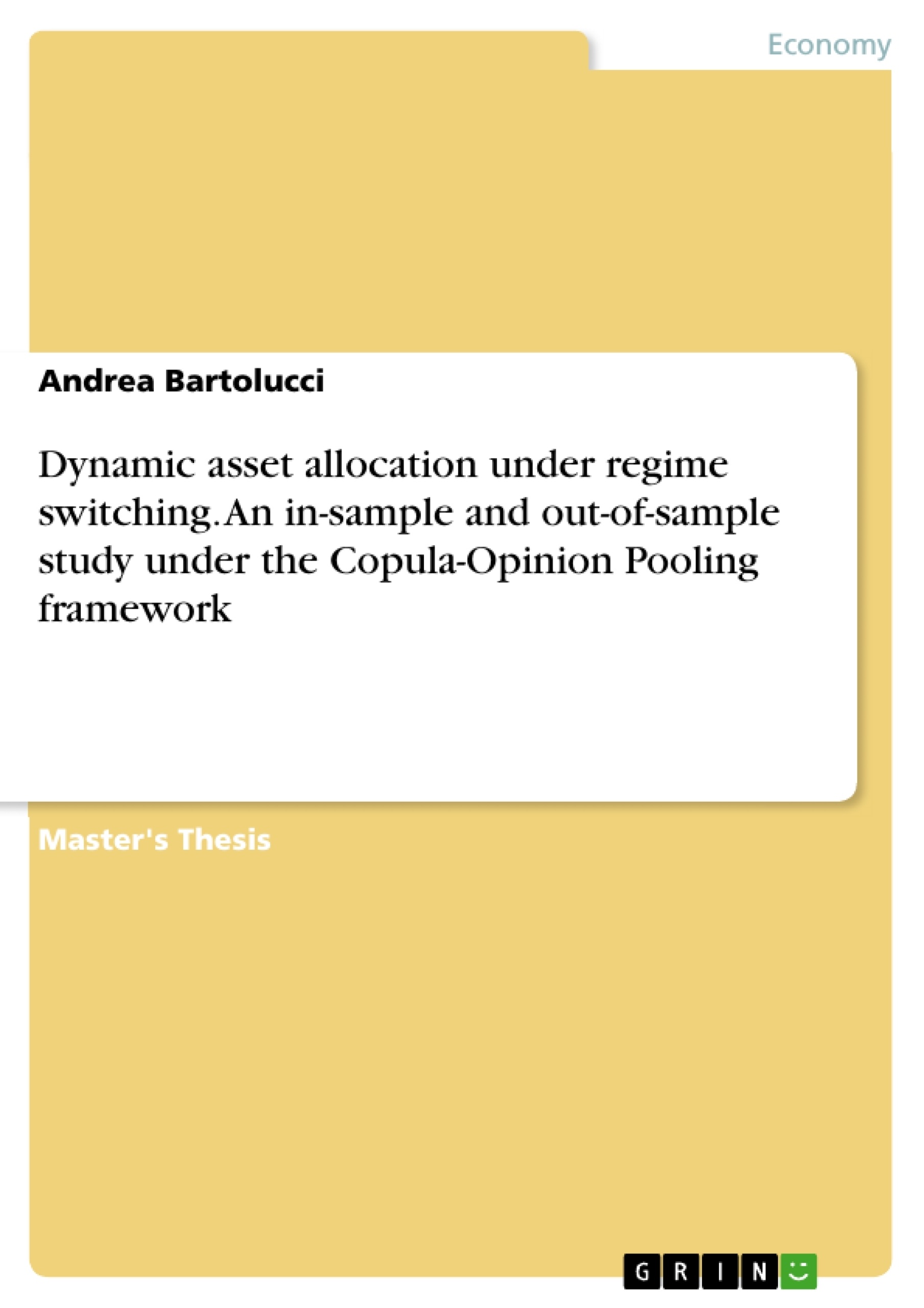
Dynamic asset allocation under regime switching. An in-sample and out-of-sample study under the Copula-Opinion Pooling framework
Masterarbeit, 2016
250 Seiten, Note: 110/110 summa cum laude
Leseprobe
Frequently asked questions
What is the main focus of this document?
This document is a language preview which comprehensively covers various aspects of asset allocation, particularly focusing on regime switching models and their effectiveness compared to single-regime models.
What key themes are explored?
The key themes include dynamic asset allocation, Markov regime switching models, multivariate time series analysis, portfolio optimization (mean-variance and CVaR), the Copula-Opinion Pooling approach, and analyzing the influence of economic factors like dividend yield and NBER recession indicators on asset returns.
What is the structure of the document?
The document is structured as follows:
- Introduction
- Literature Overview on regime-switching models
- Data description, including sources and descriptive statistics
- Model Estimation, including a theoretical background for Markov regime switching models and interpretation of results
- Asset Allocation, examining in-sample and out-of-sample performances based on various asset pricing models
- Asset Allocation based on the Copula-Opinion Pooling approach
- Conclusions
What kind of data was employed?
The data includes US small stocks (lo20), US large stocks (hi20), US Treasury bonds (tbond), the US 1-month T-Bill rate (risk_free), and the S&P 500 Dividend Yield (div_y). The time period under consideration is January 1965 – December 2010, followed by an out-of-sample period of January 2010 to December 2014.
What are the core objectives of the analysis?
The core objectives are to compare the performance of multivariate regime switching models against single regime models in the context of dynamic asset allocation and to investigate and make a comparison of the behavior of the regime switching model and the single state model in the COP framework.
What models are estimated?
Various Markov Switching Vector Autoregressive (MSVAR) models are estimated, including MMSIAH(k,p), MMSIA(k,0), MMSIAH(k,0), MMSIA(k,p), MMSIH(k,p), MMSI(k,p), and a multivariate restricted MSVAR(K,1) model. A single regime VAR(1) model is also estimated for comparison purposes.
What model selection criteria are used?
Akaike Information Criterion (AIC), Schwartz Information Criterion (SIC), Bayesian Information Criterion (BIC), and Hannan-Quinn criterion (HQC) are utilized to choose the best model specification.
What performance measures are examined?
The study examines Root Mean Squared Error (RMSE), Pearson correlation coefficient, regression analysis, expected portfolio returns, realized portfolio returns, and Sharpe ratios for portfolio performance comparison.
What is the Copula-Opinion Pooling (COP) approach?
The Copula-Opinion Pooling approach allows the investor to input views on the market, which are then combined with a prior market distribution obtained from the asset pricing model (MSVAR or VAR) to generate a posterior market distribution. This posterior distribution is used for portfolio optimization.
What are the key findings?
Key findings suggest the superiority of regime switching models against single-regime models due to their ability to capture economic regime changes. The investment portfolio performance heavily relies on the accuracy of asset returns forecasts, so a model that can account for relevant market features is crucial. However, there may be conflicting evidence of performance superiority from the two pricing models when analyzing Sharpe ratio or weights.
Details
- Titel
- Dynamic asset allocation under regime switching. An in-sample and out-of-sample study under the Copula-Opinion Pooling framework
- Hochschule
- Università degli Studi di Roma "Tor Vergata" (Faculty of Economics)
- Veranstaltung
- Quantitative finance
- Note
- 110/110 summa cum laude
- Autor
- Andrea Bartolucci (Autor:in)
- Erscheinungsjahr
- 2016
- Seiten
- 250
- Katalognummer
- V349755
- ISBN (eBook)
- 9783668367944
- ISBN (Buch)
- 9783668367951
- Dateigröße
- 5433 KB
- Sprache
- Englisch
- Schlagworte
- portfolio management asset pricing markov regime switching models copula opinion-pooling
- Produktsicherheit
- GRIN Publishing GmbH
- Preis (Ebook)
- US$ 0,99
- Arbeit zitieren
- Andrea Bartolucci (Autor:in), 2016, Dynamic asset allocation under regime switching. An in-sample and out-of-sample study under the Copula-Opinion Pooling framework, München, Page::Imprint:: GRINVerlagOHG, https://www.diplomarbeiten24.de/document/349755
- Autor werden
- Ihre Optionen
- Vertriebskanäle
- Premium Services
- Autorenprofil
- Textarten und Formate
- Services für Verlage, Hochschulen, Unternehmen

- © GRIN Publishing GmbH.
- Alle Inhalte urheberrechtlich geschützt. Kopieren und verbreiten untersagt.
- info@grin.com
- AGB
- Open Publishing
Der GRIN Verlag hat sich seit 1998 auf die Veröffentlichung akademischer eBooks und Bücher spezialisiert. Der GRIN Verlag steht damit als erstes Unternehmen für User Generated Quality Content. Die Verlagsseiten GRIN.com, Hausarbeiten.de und Diplomarbeiten24 bieten für Hochschullehrer, Absolventen und Studenten die ideale Plattform, wissenschaftliche Texte wie Hausarbeiten, Referate, Bachelorarbeiten, Masterarbeiten, Diplomarbeiten, Dissertationen und wissenschaftliche Aufsätze einem breiten Publikum zu präsentieren.
Kostenfreie Veröffentlichung: Hausarbeit, Bachelorarbeit, Diplomarbeit, Dissertation, Masterarbeit, Interpretation oder Referat jetzt veröffentlichen!
- GRIN Verlag GmbH
-
- Nymphenburger Str. 86
- 80636
- Munich, Deutschland
- +49 89-550559-0
- +49 89-550559-10
- info@grin.com
-









